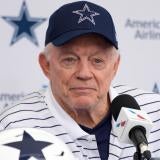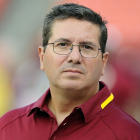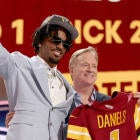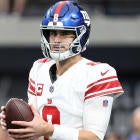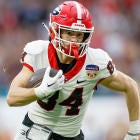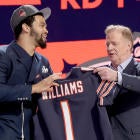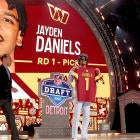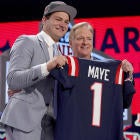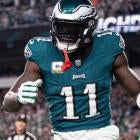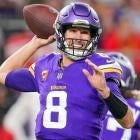In theory, trading down is the smartest strategy in the NFL Draft. It gives teams more rolls at the table.
But first, you need an inquiring team ready and willing to move up (we covered some likely candidates here), and even with expanded roster sizes coming, most teams simply do not have the room to add, say, a 10-player draft class every year.
However, for a few franchises trading down is absolutely the correct play in the 2020 NFL Draft.
1. Washington Redskins
After the Bengals -- the club set to draft the top prospect in this class, Joe Burrow -- the Redskins are in the finest position of any team in this draft, and it's not just because they have the No. 2 overall pick. It's because of their array of options, all of the reasonable ones having hugely impactful, positive outcomes.
Of course, simply taking Chase Young would be the most straightforward decision for Washington, and it would land a future superstar edge rusher.
As for the Redskins' other realistic single-prospect option, Tua Tagovailoa, a more polished quarterback prospect than Dwayne Haskins, would represent an upgrade at the game's most vital position. Of course, if Washington picked Tagovailoa at No. 2 overall, the logistics of having two first-round passers chosen in back-to-back drafts would be difficult to navigate. While there aren't many historical examples for the Redskins to use as a guide, it wouldn't be crazy to label a crowded quarterback room with Tagovailoa and Haskins a good problem to have.
But for as advanced of a quarterback prospect as I believe Tagovailoa is, throwing him to the lions behind a porous offensive line -- likely without Trent Williams in 2020 -- on a team with Terry McLaurin and not much else at receiver would be asking him to lift essentially an entire offense in a situation in which he's not accustomed to whatsoever coming from Alabama. He's ultra-accurate, robotically moves through his progressions and has natural feel for pressure inside the pocket. But he's not a stellar improviser due to average-at-best athleticism, and his arm talent isn't special. He's not exactly the type of quarterback prospect a team should feel comfortable placing into an environment not conducive to success, especially coming off an injury.
Therefore, the best decision for the rebuilding Redskins in this draft is to trade down from No. 2 overall. Haskins was far from dreadful as a rookie, and while roster statuses change rapidly in the modern-day NFL, he's deserving of at least his second pro season as the team's starter. And (likely) obtaining two first-round picks in this draft along with a few Day 2 selections would ultimately yield much more value than simply picking an excellent edge rusher and calling it a day.
Washington currently doesn't own a second-round pick in this draft, a class loaded at receiver and with a nice collection of Round 2 talent at the cornerback and offensive tackle positions. The Redskins desperately need difference-makers at all three of those spots.
They aren't like the 2019 49ers, a club that stumbled to the No. 2 overall selection last year after its starting quarterback was injured for most of the 2018 season. Washington is embarking on a classic rebuild.
Trading back is the correct move, and acquiring a huge haul for the No. 2 overall pick won't be out of the question with Tagovailoa available. That should be the primary goal for Washington -- getting as many early draft picks as possible for the No. 2 choice to diversify its talent pool instead of going Young (or even Tagovailoa) in Round 1.
2. Detroit Lions
Will the Lions trade back? Probably not. Matt Patricia and GM Bob Quinn enter this season on the hot seat, meaning they're primed to prioritize one consensus blue-chip prospect over a small collection of quality players with the long-term in mind.
But, organizationally, should Detroit move back? Absolutely.
The Lions have myriad roster holes. When that's the case, more picks are much more valuable than a superb prospect who only fills one of them.
Trey Flowers needs help opposite him at the edge-rusher spot. The interior of the defensive line is devoid of a pass rusher. Darius Slay was just traded. At receiver, Kenny Golladay is in a contract year and behind him on the depth chart are 30-year-old Marvin Jones and Danny Amendola, who turns 35 in November. The offensive line could use a few upgrades. In short, the Lions' roster is not of playoff-caliber right now in the ultra-competitive NFC.
And while they'd likely be able to get a mammoth amount of compensation for Tagovailoa if he were still on the board at No. 3 overall, the haul wouldn't be drastically smaller for Young. And you better believe if Young is available when the Lions go on the clock, there will be an abundance of calls to Lions headquarters.
Detroit does have four top-100 selections in this draft. That's good. But it won't be enough to catapult the Lions near the top of their division. Make that five or six top-100 choices and an extra second-round pick in 2021, and now we're on the right track.
3. Carolina Panthers
With new head coach Matt Rhule calling the shots, Luke Kuechly's retirement, and the club choosing not to re-sign or flat-out releasing a handful of veterans, most namely Cam Newton, the long-term future is at the forefront of the Panthers' organization right now.
They currently have a pick in each round and two in the fifth but no extra selections in 2021. Not ideal for a club at the ground floor of roster reconstruction. While the signings of Teddy Bridgewater and Robby Anderson indicate Rhule doesn't plan to tank in 2020, the 2021 season and beyond are clearly much more important.
Yes, a blue-chip prospect will likely be there when Carolina goes on the clock, which, for fans, will be very enticing. But instead of snatching up a Jeffrey Okudah, Henry Ruggs, or Javon Kinlaw, the Panthers should leverage their rebuilding status into a sizable trade back to garner future assets.
There'll likely be teams interested in one of the top offensive tackles in this class, or maybe one of the highly coveted wide receivers like Jerry Jeudy or CeeDee Lamb. Because it's a top-10 selection, Carolina should ask for a considerable return. Last year, the Broncos got a second and a 2020 third to slide from No. 10 to No. 20 overall. That compensation should be the starting point for the Panthers, and with the distance future in mind, Carolina could probably get even more than usual if they tell inquiring teams they'd prefer picks in 2021 or, heck, 2022.
4. San Francisco 49ers
The 49ers made one of the biggest trades of the offseason when they sent star defensive tackle DeForest Buckner to the Colts for the No. 13 overall pick in the 2020 Draft. A bold and prudent decision by John Lynch and Co.
As owners of that selection and No. 31 overall, San Francisco initially appears to be in a luxurious situation in this draft. And two first-round picks is pretty luxurious. However, their next pick doesn't come until the fifth round (!), No. 157 overall. Sure, the 49ers have a wide-open Super Bowl window, so conventional wisdom would suggest staying put at No. 13 and drafting the prospect who'd be a quick-fix for any glaring problem would be the correct course of action.
But the 49ers want to sustain their status as a top NFC contender beyond the 2020 campaign, particularly with a young head coach -- Kyle Shanahan only turns 41 this December -- an a relatively young GM in John Lynch at age 48. To do that, they have to stay at least a year ahead and maintain the talent level on the roster well into the future.
Joe Staley turns 36 in August. Richard Sherman is 32. Those are key cogs in San Francisco at premium positions. Penciled in right guard Tom Compton is almost 31. And despite Shanahan's uncanny ability to scheme passing efficiency, the wideout group consists of Deebo Samuel then a variety of question marks. George Kittle's going to break the bank after this season. What happens with Jimmy Garoppolo when his cap hit nearly hits the $27 million mark in 2021 and his dead cap would only be $2.8 million if released?
Don't get me wrong, the 49ers have many foundational pieces, and Shanahan's brilliance is time-tested. But moving back into the early 20s and grabbing a receiver there while adding a few picks on the second day of this draft would go a long way in San Francisco reloading for the long-term.
5. Atlanta Falcons
This suggestion comes with a caveat -- if one of Jeudy, Ruggs, or Lamb are on the board when the Falcons go on the clock at No. 16 overall, then I believe the wisest move for Atlanta would be to trade down.
At that point, there'll likely be an abundance of teams like the Eagles, Patriots, Vikings, Ravens eager to snatch one of those top-tier prospects in this draft class at receiver.
Atlanta moved a second-rounder in the trade for Hayden Hurst, and the offense looks pretty loaded. The defense is in dire need of an explosive edge rusher, the cornerback room is missing a true No. 1 with Desmond Trufant gone, and Grady Jarrett could use a disruptive running mate on the interior of the team's defensive line.
The Falcons' Super Bowl window is closing given the age of their two marquee players -- Matt Ryan and Julio Jones -- but that doesn't mean adding another second-round selection in this draft would be foolish at the price of moving back a few spots in Round 1.








